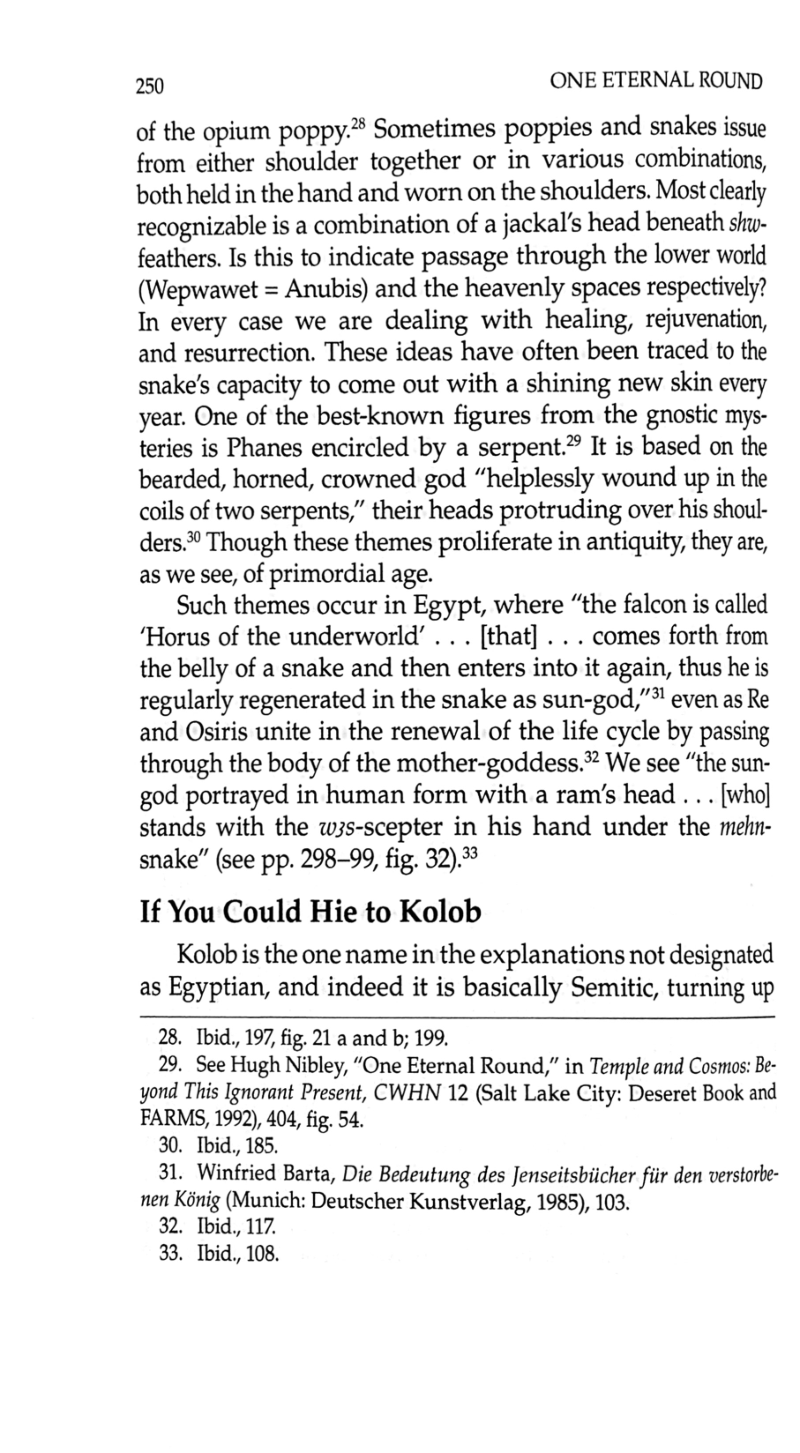Hugh Nibley and Michael D. Rhodes give proposed etymology for Kolob.
- Type
- Book
- Hearsay
- DirectSecondary
- Reference
Hugh Nibley and Michael D. Rhodes, One Eternal Round, The Collected Works of Hugh Nibley: Volume 19 (Salt Lake City: Deseret Book; Provo: Foundation for Ancient Research and Mormon Studies, 2010), 250–252
- Scribe/Publisher
- Foundation for Ancient Research and Mormon Studies, Deseret Book
- Audience
- Reading Public
- Transcription
Kolob is the one name in the explanations not designated as Egyptian, and indeed it is basically Semitic, turning up with two principal meanings in the West Semitic languages. The late professor Louis C. Zucker suggested that Smith’s “Kolob . . . may be a variant of Kokob (star),” he being possibly unaware of one of the most fruitful roots in Arabic where the guttural first consonant gives the vowel an o-sound. Let us look at Lane’s dictionary.
qlb
verb: to alter, change, invert, turn upside down, turn over and over, go flip-flop.
noun: “Heart,” hence intellect or intelligence.
adjective: genuine or pure in respect of origin or lineage, “holding a middle place among his people.”
“A certain bright star (Alpha Scorpio = Antares) in the 18th mansion of the Moon”
"There are also 3 similar appellations of other stars, esp. Regulus, called qalb al-ʿasad, the heart of the Lion.”
The explanation “called Kolob because it is near to me” suggests Semitic qrb, meaning “to be near”; Kolob may accordingly be related to the rich Indo-European root klb, as in kleben, kolophon, cleave (unto), clyppian (OE, hug close), clap, clasp, clip (together), couple, clabber, etc.
Though the words qalb (heart) and kalb (dog) are different, the ancients could not keep them apart, as was inevitable to people always seeking puns and parallels. One ancient saying quoted in Lane shows a more than facetious connection between the two: “izza tala’ al-Qalb ja’a’ šita ka’l-Kalb—when the Heart-Star rises winter comes in like the Dog-star.” What is significant here is that these two actually are the brightest stars in the heavens, Sirius and Canopus, and are freely interchangeable. The Arabic kalb denotes what we call “the constellation of Canis Major (the Big Dog), and its principal star is Sirius,” which we call the Dog-star. Nearby is Procyon, the Little Dog-star. To complicate things, Sirius, the brightest star, has a rival for the title of Kalb in the red-giant star Antares.
The experts of old inevitably came to disagree as to which might be the Dog-star. Sirius, the brightest star in the sky, naturally qualifies for a number of roles in the Egyptian manner. Giorgio de Santillana and Hertha von Dechend comment on “the amazing significance of Sirius as leader of the planets . . . ruling over the ‘three worlds.’” But that third candidate for leadership, the second brightest star of all, was Canopus, which for the Egyptians was the heart-star par excellence, but which the Arabs also called Kalb the Dog! Thus we see how heart and dog get switched, both being used to designate the most important star in the heavens. The Egyptians designated Canopus by drawing a picture of a human heart suspended as the bob on a plumb line, the cosmic plumb line from which all the universe was measured (fig. 26). As de Santillana and von Dechend put it, “the determinative sign for ‘heart’ often figures as the plumb bob at the end of a plumb line coming from the well-known astronomical device, the merkhet. Evidently ‘heart’ is something very specific, as it were the ‘center of gravity.’” Here he refers us to the Wörterbuch, where the basic idea of heart is given not surprisingly as “the middle, the center.”
- Citations in Mormonr Qnas
The B. H. Roberts Foundation is not owned by, operated by, or affiliated with the Church of Jesus Christ of Latter-day Saints.

